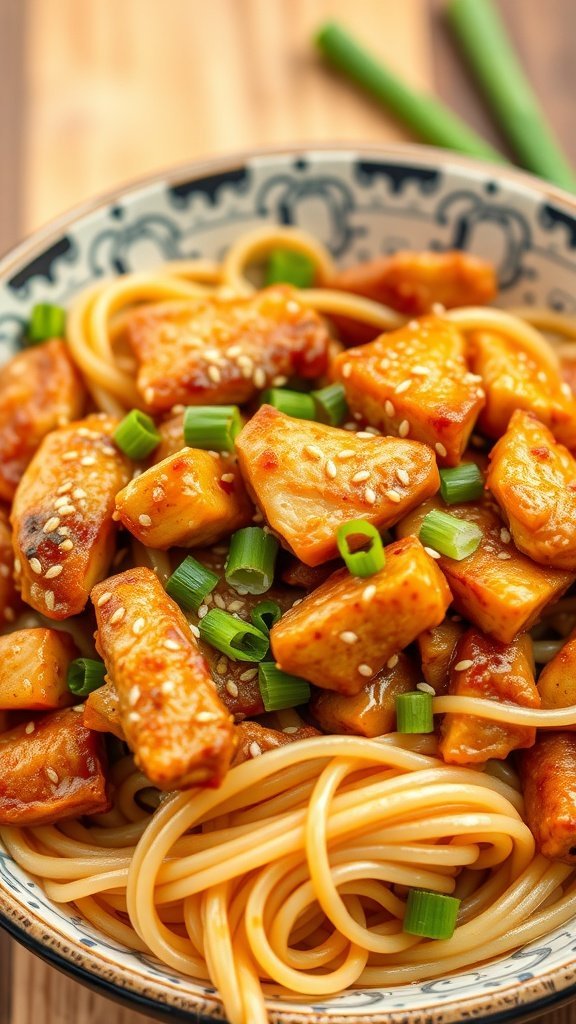Quick Springtime Stir-Fries for Busy Nights
This post may contain affiliate links. As an Amazon Associate, I earn from qualifying purchases. If you click and buy, we may earn a small commission at no extra cost to you. Learn more.
As spring arrives, our cooking habits change. Fresh produce is now more available, perfect for new spring stir-fries. These recipes are a healthy and tasty choice for busy weeknights. They’re quick to make and can be customized to your liking.
Easy stir-fry recipes offer a variety of healthy and flavorful dishes. They’re a great way to eat more veggies. You can use chicken, beef, or tofu as your protein. In this article, we’ll talk about the benefits of spring stir-fries, how to prepare them, and share some easy recipes to start with.
Contents
- 1 The Joy of Spring Stir-Fries
- 2 Essential Ingredients for Spring Stir-Fries
- 3 Quick Cooking Techniques for Stir-Frying
- 4 Easy Spring Stir-Fry Recipes
- 5 Meal Prep Ideas for Busy Nights
- 6 Tips for Customizing Your Stir-Fry
- 7 Pairing Stir-Fries with Sides
- 8 Storing and Reheating Leftover Stir-Fries
- 9 Health Benefits of Stir-Frying
- 10 Serving Suggestions for Spring Gatherings
- 11 The Environmental Benefits of Seasonal Cooking
- 12 Final Thoughts on Spring Stir-Fries
The Joy of Spring Stir-Fries
As the seasons change, it’s time to update our diets. Spring is ideal for introducing seasonal stir-fry dishes that are tasty and nutritious. These meals are great for any day, whether it’s a busy weeknight or a special event.
Spring stir-fries offer a wide range of ingredients. You can use asparagus, bell peppers, broccoli, and carrots, among others. Here are some perks of using seasonal ingredients:
- Fresh flavors and textures
- Higher nutrient content
- Support for local farmers
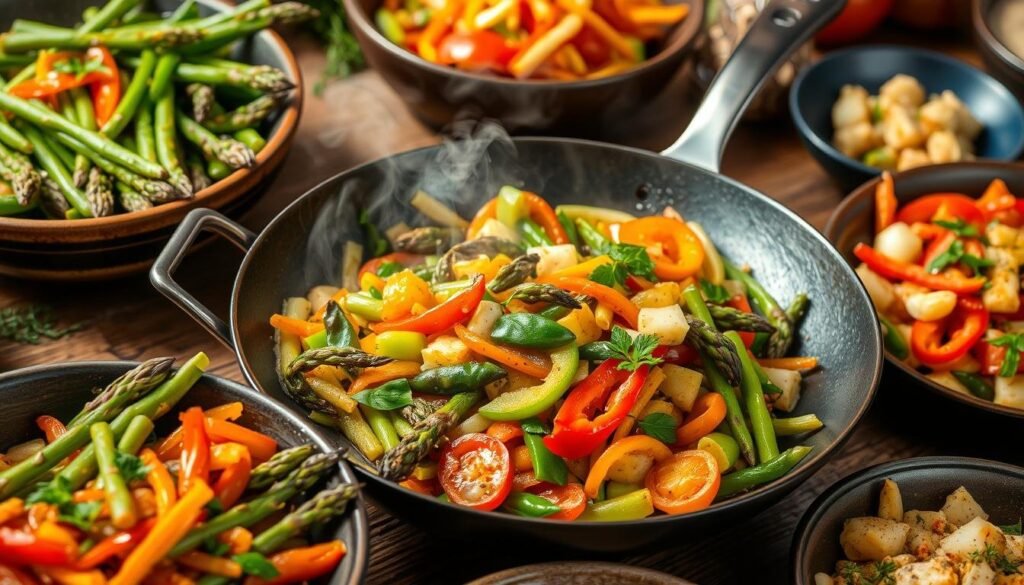
By using seasonal flavors and ingredients, you make healthy stir-fry meals that are both healthy and tasty. Whether you’re an experienced cook or just starting, spring stir-fries are a fun way to explore new recipes with the season’s best produce.
Embracing Seasonal Ingredients
Choosing seasonal ingredients is good for you and the planet. It helps reduce your carbon footprint and supports local farmers. So, why not try making spring stir-fries and enjoy cooking with fresh, seasonal ingredients?
Nutritional Benefits of Spring Produce
Spring produce is full of vitamins, minerals, and antioxidants. Adding these to your stir-fries makes your meals not only tasty but also healthy. Some key benefits include:
- Boosted immunity
- Increased energy levels
- Support for healthy digestion
Essential Ingredients for Spring Stir-Fries
Creating tasty spring stir-fries starts with fresh, seasonal ingredients. A stir-fry with seasonal vegetables is not only healthy but also adds variety to your meals. Visit your local farmer’s market for fresh produce like carrots, zucchini, and mushrooms.
For a quick stir-fry, mix your favorite vegetables with proteins like chicken, beef, or tofu. Adding nuts or seeds, like almonds or sesame seeds, gives your dish crunch. The possibilities are endless, making it easy to create tasty stir-fries for any occasion.
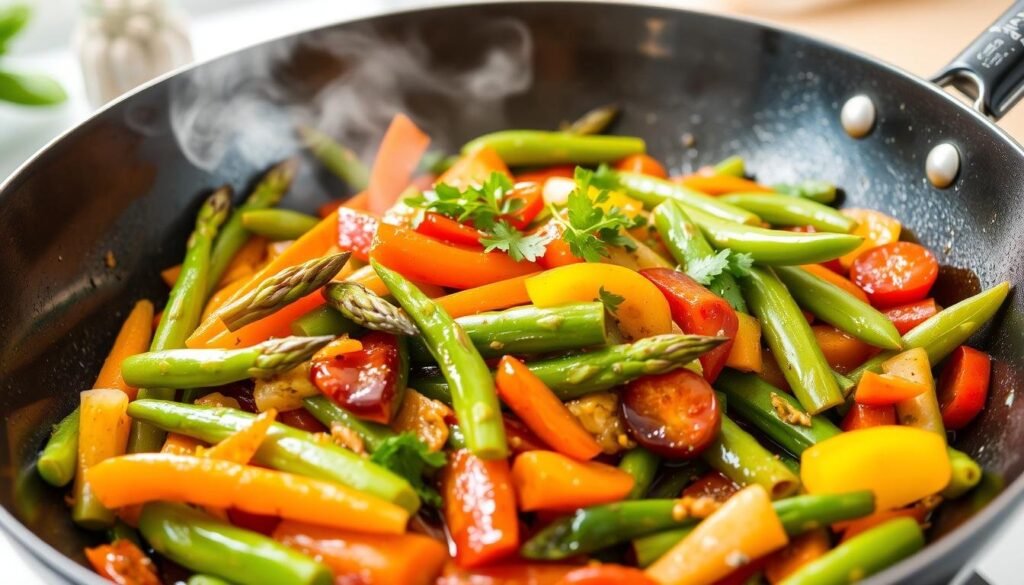
Fresh Vegetables to Consider
- Carrots
- Zucchini
- Mushrooms
- Bell peppers
- Snow peas
Flavorful Proteins You Can Use
- Chicken breast
- Beef strips
- Tofu
- Shrimp
- Pork tenderloin
By mixing these ingredients, you can make a variety of healthy and delicious stir-fries. Whether you want something classic or adventurous, the key is to have fun and try new things.
Quick Cooking Techniques for Stir-Frying
To make tasty and simple stir-fry recipes, you need to learn quick cooking methods. Choosing the right wok or pan is key. A big skillet or wok with a non-stick surface works best for stir-fries. It helps cook food quickly and evenly.
Heat control is very important for quick stir-fry ideas. High heat for a short time keeps nutrients and colors in the food. But, you must adjust the heat to avoid burning or overcooking.
Choosing the Right Wok or Pan
Popular stir-fry cookware includes carbon steel woks, cast iron skillets, and non-stick pans. Look for a material, size, and handle type that suits you. A good wok or pan spreads heat well and has a handle for easy stirring.
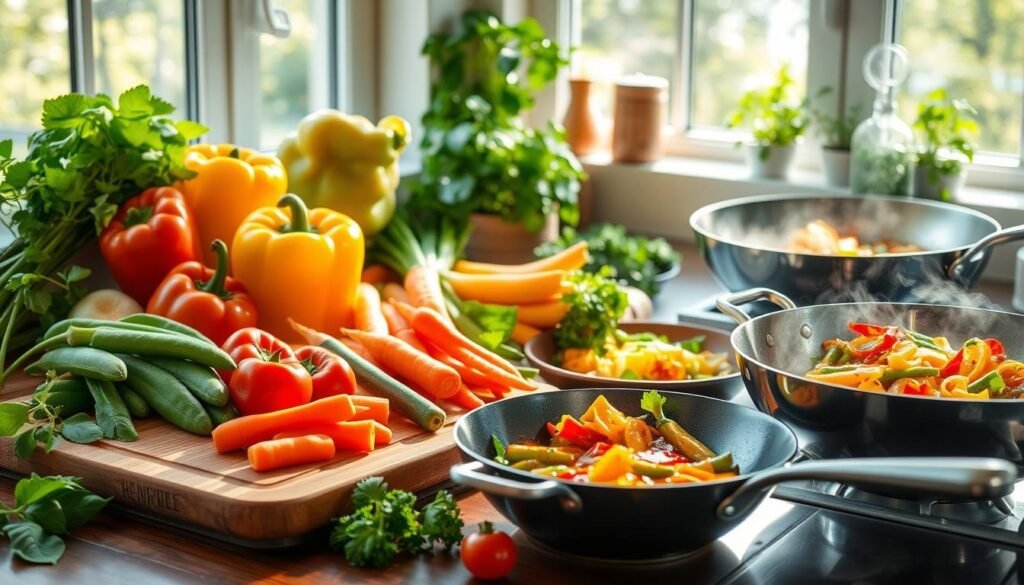
Heat Control Tips for Perfect Stir-Fries
To get perfect stir-fries, controlling the heat is key. Here are some tips:
- Use high heat for quick cooking and to preserve nutrients.
- Adjust the heat as needed to prevent burning or overcooking.
- Stir constantly to ensure even cooking.
By using these quick cooking techniques and tips, you can make many easy stir-fry recipes. Enjoy delicious and healthy meals with your loved ones.
Easy Spring Stir-Fry Recipes
Exploring spring stir-fries is exciting. We’ll share three easy and tasty recipes. These meals are great for quick, healthy dinners.
Spring stir-fries are all about simplicity. Let fresh ingredients take center stage. With basic ingredients and techniques, you can make many healthy dishes.
Colorful Vegetable Medley Stir-Fry
This recipe is a great starting point. Sauté colorful veggies like bell peppers, carrots, and broccoli. Add oil, garlic, and ginger. Serve over rice or noodles for a quick dinner.
Chicken and Asparagus Stir-Fry
This is a classic spring stir-fry. Marinate chicken in your favorite seasonings. Stir-fry it with asparagus, bell peppers, and onions. Serve with steamed rice or noodles for a complete meal.
Shrimp and Snap Peas Stir-Fry
This recipe adds protein and crunch. Sauté shrimp and snap peas with oil, garlic, and ginger. Serve over rice or noodles. Add soy sauce or stir-fry sauce for extra flavor.
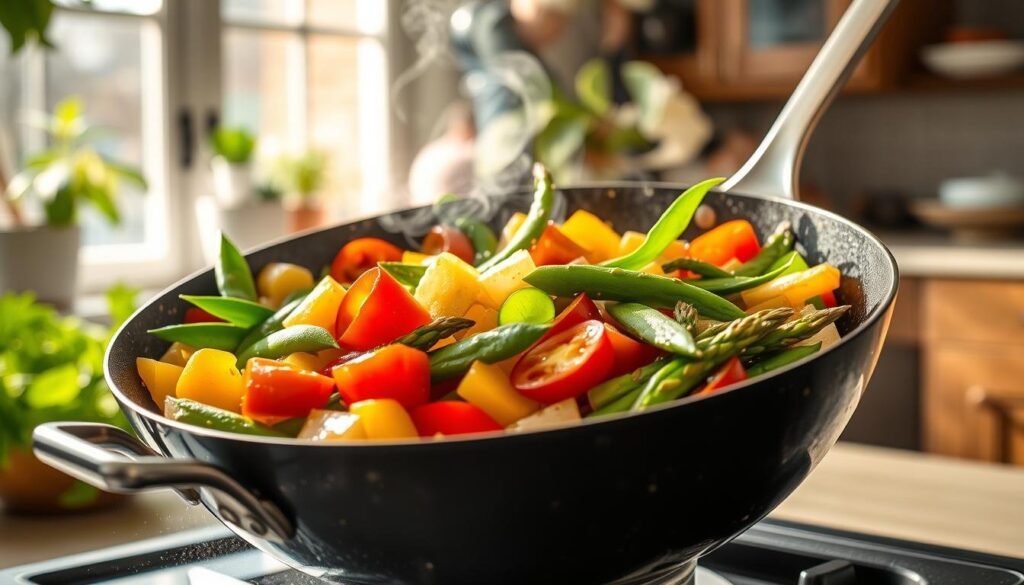
These easy recipes are perfect for quick, healthy dinners. With simple ingredients and techniques, you can make many tasty dishes. Try them out and enjoy spring’s flavors in your kitchen.
Meal Prep Ideas for Busy Nights
Meal prep is a game-changer for quick stir-fry ideas. It saves time and reduces stress on busy nights. This way, you can make healthy and tasty stir-fries even when you’re in a rush.
For easy stir-fry recipes, prep ingredients like veggies, proteins, and sauces ahead of time. Chop veggies like bell peppers, carrots, and broccoli, and keep them in airtight containers in the fridge. Cook proteins like chicken, beef, and tofu and store them in the fridge or freezer for later. Also, make quick sauces like stir-fry sauce and soy sauce in advance and keep them in the fridge for up to a week.
Prepping Ingredients in Advance
- Chop vegetables like bell peppers, carrots, and broccoli
- Cook and store proteins like chicken, beef, and tofu
- Make quick sauces like stir-fry sauce and soy sauce
Quick Sauces to Have on Hand
Having quick sauces ready can greatly enhance your stir-fries’ flavor and quality. Make a batch of stir-fry sauce or soy sauce on the weekend and store it in the fridge. You can also buy pre-made sauces, but always check the ingredients and nutrition label to match your dietary needs.
Tips for Customizing Your Stir-Fry
Customizing your stir-fry with seasonal vegetables is a great way to make healthy meals. You can change ingredients and adjust spice levels. This lets you create many dishes that are tasty and good for you. For instance, you can add chicken, beef, or tofu to make a stir-fry that fits your diet.
Stir-fries with seasonal vegetables offer endless possibilities. You can use different veggies like bell peppers, carrots, and broccoli. You can also try various sauces and seasonings, like soy sauce, garlic, and ginger. This adds depth and flavor to your stir-fry.
Swapping Out Ingredients
- Try using different types of protein, such as chicken, beef, or tofu
- Experiment with various vegetables, such as bell peppers, carrots, and broccoli
- Use different types of sauces and seasonings, such as soy sauce, garlic, and ginger
Adjusting Spice Levels
To make a stir-fry that suits your taste, adjust the spice levels. Add more chili flakes for a spicy stir-fry or less garlic for a milder taste. Customizing your stir-fry lets you enjoy healthy meals that are also delicious.
Pairing Stir-Fries with Sides
Pairing spring stir-fries with the right sides can make your meal better. You can choose from simple steamed veggies to flavorful grains like jasmine rice. This adds variety to your meals.
For a complete meal, try pairing stir-fries with brown rice. It adds a nutty flavor and extra fiber. Roasted veggies like asparagus or Brussels sprouts also work well. Season them with herbs and spices to match your stir-fry’s taste.
Best Rice Varieties for Spring Dishes
Jasmine rice and brown rice are great for spring dishes. Jasmine rice goes well with light flavors, while brown rice is hearty and wholesome. You can also try basmati or wild rice to find the best match for your stir-fries.
Creative Ways to Serve Noodles
Noodles are also a great side for spring stir-fries. Try serving stir-fry noodle bowls with your favorite ingredients and a savory sauce. Noodle salads are another option. They can include veggies, proteins, and nuts, all dressed in a light vinaigrette.
Storing and Reheating Leftover Stir-Fries
To enjoy healthy stir-fry meals, it’s key to store and reheat leftovers right. This keeps the quality and taste of your quick stir-fry ideas. When storing leftovers, use airtight containers and label them with the date. This helps you use the oldest items first.
For the best storage tips, consider these:
- Store leftovers in the fridge at 40°F (4°C) or below.
- Use shallow containers to cool leftovers fast, cutting down bacterial growth risk.
- Reheat leftovers to 165°F (74°C) to ensure food safety.
When reheating your stir-fries, you can use microwaving, stir-frying, or oven heating. These methods keep the nutrients and flavor of your healthy stir-fry meals. By following these tips, you can enjoy nutritious and tasty meals even on busy nights.
Remember, proper storage and reheating are key for keeping your stir-fries good. By taking a few simple steps, you can enjoy healthy and flavorful meals. This makes the most of your quick stir-fry ideas.
Health Benefits of Stir-Frying
Stir-frying is a great way to cook that’s good for your health. It helps keep the nutrients in veggies, which is key for spring stir-fries. This method uses little water and cooks fast, saving vitamins and minerals in veggies.
Stir-frying is also low in calories. It uses just a bit of oil, making dishes lighter. This makes stir-fries a smart choice for those watching their weight. To keep veggies healthy, use a wok, cook fast, and stir often.
Low-Calorie Cooking Method
Stir-frying is perfect for cutting down calories. It uses a small amount of oil and cooks quickly. This way, you avoid soaking up too much oil, keeping your dish low in calories.
Preserving Nutrients in Vegetables
To keep veggies healthy in stir-fries, use little water and cook fast. A wok or big skillet, high heat, and constant stirring help. These tips make stir-fries tasty and full of nutrients, adding value to a healthy diet.
Serving Suggestions for Spring Gatherings
As the weather gets warmer, spring gatherings are perfect for showing off tasty stir-fry recipes. The way you present your spring stir-fries is as key as their flavor. Add some color with fresh herbs or edible flowers to make it a hit at your event.
A beautifully plated spring stir-fry can make your mealtime special. Mix different colors and textures to make it look good. Try combining crunchy veggies like bell peppers and carrots with soft noodles or rice. Finish it off with a sprinkle of toasted sesame seeds.
Creative Plating Ideas
- Use a mix of cooked and raw ingredients for depth and interest.
- Try different shapes and sizes of dishes for a unique look.
- Get creative with garnishes like sliced citrus fruits or pickled ginger for flavor and color.
Making Stir-Fries a Centerpiece Dish
Make spring stir-fries the star of your gathering for a memorable meal. With a bit of creativity, you can turn a simple stir-fry into a stunning dish. Impress your guests with easy stir-fry recipes, whether it’s a small group or a big crowd.
The Environmental Benefits of Seasonal Cooking
Exploring seasonal stir-fry dishes highlights the environmental perks of using seasonal ingredients. Choosing local produce cuts down on carbon emissions and supports local farmers. This method not only helps the planet but also makes our meals healthier and more flavorful.
Some key advantages of seasonal cooking are:
- Reduced transportation emissions: Picking seasonal ingredients means less need for long-distance transport, a big source of greenhouse gases.
- Support for local farmers: Buying from local farmers boosts the local economy and supports sustainable farming.
- Promotion of biodiversity: Trying new seasonal ingredients and recipes helps preserve traditional farming and boosts biodiversity.
To positively impact the environment, we can start with small changes in our cooking. Shopping at farmers’ markets, joining CSA programs, and picking seasonal ingredients for stir-fries are good steps. These actions help reduce our environmental footprint and support a healthier planet.
Reducing Your Carbon Footprint
Seasonal cooking greatly reduces our carbon footprint. By opting for seasonal ingredients, we cut down on energy-intensive farming and long-distance transport. This not only helps the environment but also makes our meals healthier for us and the planet.
Supporting Local Farmers
Seasonal cooking also supports local farmers. Buying from local farmers promotes sustainable agriculture and boosts the local economy. This approach benefits the environment and makes our meals more nutritious and delicious.
Final Thoughts on Spring Stir-Fries
As warmer weather comes, adding spring stir-fries to your meals can become a special tradition. These dishes are quick, easy, and full of fresh ingredients. They also let you cook together with your family.
Encouraging Family Involvement in Cooking
Stir-fry recipes are a great way to bond and teach healthy eating. Kids can help chop veggies, measure, and even stir in the wok. This makes memories and helps them appreciate their food more.
Making It a Spring Tradition
Make spring stir-fries a regular part of your family’s life. It’s a fun way to welcome the season with tasty dishes. Over time, everyone can add their favorite ingredients, making it a special part of your spring.





